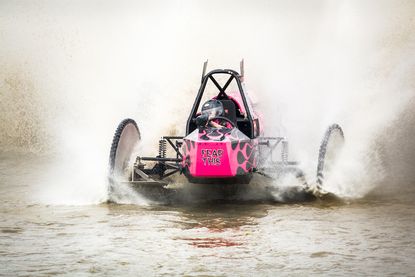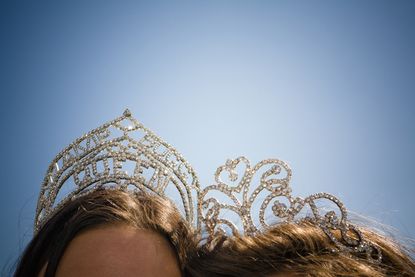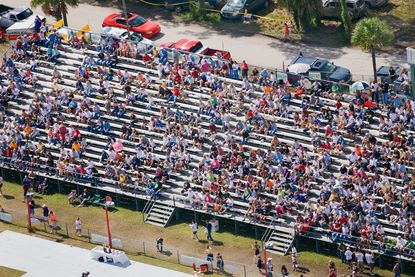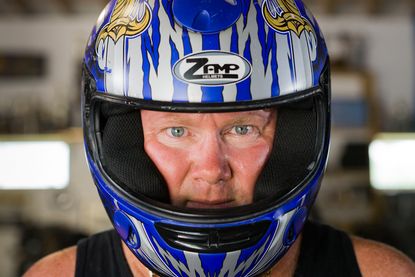Down home at the Mile O' Mud
A Brooklyn-based photographer explores his Floridian roots by way of a decidedly unique swampland sport



(Malcolm Lightner)

(Malcolm Lightner)The unique sporting event — soon to be commemorated by Lightner in a book entitled Mile O' Mud — originated in the photographer's backyard of Collier County, Florida. In the 1970s, the young Lightner lived in a trailer park just down the street from the first official swamp buggy track. For three weekends each year, daredevils in homemade, wild contraptions wheeled around a waterlogged course, spewing up water, and occasionally flipping right into the muck. The noise, the adrenaline — it was exhilarating.Despite his proximity, Lightner's childhood experiences at the track were abbreviated — "the races were somewhat like the Wild West, where people carried guns in holsters and drank heavily," he recalls.In short: Swamp buggy tracks were no place for children.

(Malcolm Lightner)

(Malcolm Lightner)The "no kids allowed" mentality relaxed a little each October, when Lightner's mother would take him and his sister to the local Swamp Buggy parade, which marked the opening of both the hunting and racing seasons."The parade was a community celebration of swamp buggy culture, where drivers could show off the individuality and mechanical ingenuity of their buggy designs," Lightner says. "Women donned calico frocks, a Swamp Buggy Queen was crowned, and men sported bushy beards in anticipation of the Swamp Buggy Days beard contest."

(Malcolm Lightner)

(Malcolm Lightner)The New York city transplant couldn't shake the memories of his time spent at the track, and so he was delighted to discover that, all these years later, the swamp buggy racing community was still alive. In 2002, Lightner headed to Naples to begin documenting the subculture, and continued to make an annual pilgrimage until 2013."On my first visit to the track, I drove into the parking lot, heard the engines of the buggies roar, and witnessed the great plumes of water trailing behind the boat-dragster hybrids," Lightner says. "I could feel the vibrations from the raw horsepower pound against my chest, and it almost took my breath away. I thought to myself, 'this is going to be fun!'"

(Malcolm Lightner)

(Malcolm Lightner)While Lightner initially focused on the boat-dragster buggies themselves, he quickly became more fascinated by the web of relationships in the community, and his own connections to the place and the sport.Lightner's great-uncle R.L. Walker was one of the first swamp-buggy drivers, and he helped formalize the race into a legitimate sporting event, which officially launched in 1949. In his custom-built buggy Flying Saucer, R.L. was Swamp Buggy King in 1951 and 1952."In my own mind, this project felt like time travel," Lightner says. "I unveiled family connections that I did not know existed."

(Malcolm Lightner)

(Malcolm Lightner)But Lightner notes that his project is tinged with bittersweet feelings."The community and my family have seen better times," he says. "I am reminded that life is indeed short and full of unexpected bumps in the road — all the more reason to let go and enjoy the ride."

(Malcolm Lightner)**See more of Lightner's work via his website, and follow him on Twitter and on Instagram**
Sign up for Today's Best Articles in your inbox
A free daily email with the biggest news stories of the day – and the best features from TheWeek.com
Stephanie is an editorial assistant at TheWeek.com. She has previously worked for USA Today and Modern Luxury Media.
-
 What is Mitch McConnell's legacy?
What is Mitch McConnell's legacy?Talking Point Moving on after a record-setting run as Senate GOP leader
By Joel Mathis, The Week US Published
-
 'A man's sense of himself is often tied to having a traditionally masculine, physical job'
'A man's sense of himself is often tied to having a traditionally masculine, physical job'Instant Opinion Opinion, comment and editorials of the day
By Justin Klawans, The Week US Published
-
 7 festive hotels that get decked out for the holidays
7 festive hotels that get decked out for the holidaysThe Week Recommends These properties shimmer and shine all December long
By Catherine Garcia, The Week US Published